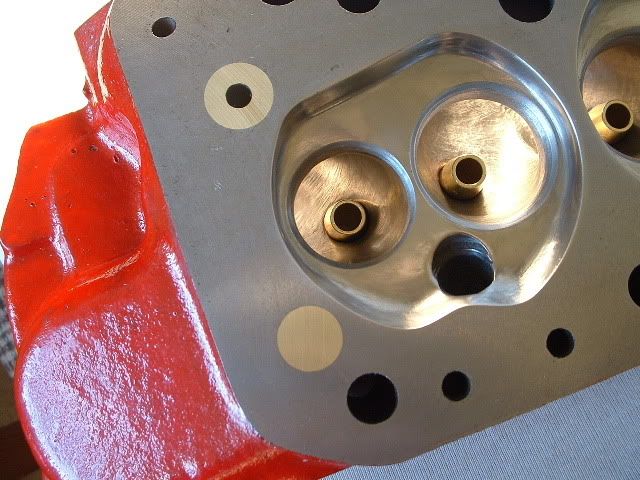| Page: |
| Home > Technical Chat > A Series simulation thread. | |||||||
|
510 Posts Member #: 1592 Smart Guy! mainland europe near ze germans |
14th Nov, 2014 at 12:25:38pm
On 12th Nov, 2014 adcyork said: On 12th Nov, 2014 Paul S said:
A reverse engineering exercise such as what is going on here, with a current engine configuration requires the model to be correlated against cylinder pressure (and derived burn data) and pressures/temps from the relevant ducts. This allows the Wiebe model and other parameters to be tweaked to bring the model into a correlated state. Simply correlating the power and torque curves by tweaking the model is highly inaccurate and only a small part of the picture. If this was the only goal then a number of engines could all well look very close to an A-series engine on paper I'd rather have sensor data as well but I don't have the cash to spring for a multi sensor setup. However this is not a start from scratch program and has been verified (but not for siamese models I reckon) You have to tweak a bit but you have to keep it sensible. You can force a super high correlation when you start changing values at will. But the simulation will be rubbish as it looses all predictive capabilities. I'm currently working to see it I can help somebody out with an odd idea. Luckily he has a dyno at home so that makes it a lot more effective.. That sir, is not rust, it is the progressive mass reduction system
|
||||||
|
510 Posts Member #: 1592 Smart Guy! mainland europe near ze germans |
27th Nov, 2014 at 10:02:06am
Paul do you have data for mach numbers at the valve at about 8k ? one inner and one outer if at all possible
That sir, is not rust, it is the progressive mass reduction system
|
||||||
|
8604 Posts Member #: 573 Formerly Axel Podland |
27th Nov, 2014 at 12:35:06pm
I don't have Mach numbers.
Saul Bellow - "A great deal of intelligence can be invested in ignorance when the need for illusion is deep."
|
||||||
|
510 Posts Member #: 1592 Smart Guy! mainland europe near ze germans |
28th Nov, 2014 at 05:40:23pm
Hi
That sir, is not rust, it is the progressive mass reduction system
|
||||||
|
510 Posts Member #: 1592 Smart Guy! mainland europe near ze germans |
19th Dec, 2014 at 08:43:36am
Paul you where right about my fmep numbers btw . I sorted them
That sir, is not rust, it is the progressive mass reduction system
|
||||||
|
8604 Posts Member #: 573 Formerly Axel Podland |
19th Dec, 2014 at 09:56:46am
Jolly good.
Saul Bellow - "A great deal of intelligence can be invested in ignorance when the need for illusion is deep."
|
||||||
|
8604 Posts Member #: 573 Formerly Axel Podland |
19th Dec, 2014 at 10:33:26am
Just to clarify: the data is inlet velocities for my latest 998 with a 12G295 head, 33mm inlets and tuned length inlet and exhaust manifolds. Saul Bellow - "A great deal of intelligence can be invested in ignorance when the need for illusion is deep."
|
||||||
|
510 Posts Member #: 1592 Smart Guy! mainland europe near ze germans |
19th Dec, 2014 at 11:25:46am
I get significantly higher velocities at the inners as well
That sir, is not rust, it is the progressive mass reduction system
|
||||||
|
510 Posts Member #: 1592 Smart Guy! mainland europe near ze germans |
11th Nov, 2015 at 02:59:08am
If somebody is interested I posted some simulation stuff on Long Outer Branch manifolds on me blog. Its use for turbo's is pretty much zero but hey .. if you want to run a 8000 rpm 998 give me a PM
Edited by Sir Yun on 11th Nov, 2015. That sir, is not rust, it is the progressive mass reduction system
|
||||||
|
8604 Posts Member #: 573 Formerly Axel Podland |
11th Nov, 2015 at 09:12:07am
Interesting that the longer outer branch increases the trapped mass/power on the inner cylinders Saul Bellow - "A great deal of intelligence can be invested in ignorance when the need for illusion is deep."
|
||||||
|
510 Posts Member #: 1592 Smart Guy! mainland europe near ze germans |
11th Nov, 2015 at 02:47:54pm
That sir, is not rust, it is the progressive mass reduction system
|
||||||
|
8604 Posts Member #: 573 Formerly Axel Podland |
12th Nov, 2015 at 09:38:16am
I'm not sure that I agree with your logic. The data on your blog would suggest otherwise.
Saul Bellow - "A great deal of intelligence can be invested in ignorance when the need for illusion is deep."
|
||||||
|
510 Posts Member #: 1592 Smart Guy! mainland europe near ze germans |
13th Nov, 2015 at 08:31:39pm
These are the power per cylinder # 1&4 for both configs.
Edited by Sir Yun on 13th Nov, 2015. That sir, is not rust, it is the progressive mass reduction system
|
||||||
|
8604 Posts Member #: 573 Formerly Axel Podland |
14th Nov, 2015 at 01:22:53pm
Well I'm confused Saul Bellow - "A great deal of intelligence can be invested in ignorance when the need for illusion is deep."
|
||||||
|
510 Posts Member #: 1592 Smart Guy! mainland europe near ze germans |
14th Nov, 2015 at 05:28:05pm
well it is more the short centre in combo with the longer outers. but I already had SCB for an other config :)
Edited by Sir Yun on 15th Nov, 2015. That sir, is not rust, it is the progressive mass reduction system
|
||||||
|
510 Posts Member #: 1592 Smart Guy! mainland europe near ze germans |
4th May, 2016 at 01:52:09pm
I have seen the in-cylinder pressure figures and they are surprisingly within about 1% of the predicted values. Can't share much else but it is pretty nice to see that the simulation seems to work well That sir, is not rust, it is the progressive mass reduction system
|
||||||
|
224 Posts Member #: 9987 Senior Member Amsterdam |
4th May, 2016 at 04:32:30pm
Not bad, especially considering the average physician I know can not even manage to hang a painting on the wall without screwing up big time Edited by Evoderby on 4th May, 2016. |
||||||
|
224 Posts Member #: 9987 Senior Member Amsterdam |
4th May, 2016 at 04:33:08pm
Sorry, double post....
Edited by Evoderby on 4th May, 2016. |
||||||
|
510 Posts Member #: 1592 Smart Guy! mainland europe near ze germans |
5th May, 2016 at 02:48:18pm
The 3-1 produces less power on the inner cylinders. We have measured numbers for that. As the main developement focus is a much wackier setup there is no proof for the short centre long outer idea but it is basically standard exhaust theory rigidly applied. That sir, is not rust, it is the progressive mass reduction system
|
||||||
|
224 Posts Member #: 9987 Senior Member Amsterdam |
5th May, 2016 at 04:25:43pm
Is your software capable of running stepped header configurations as seen in superbikes a.o.?
Edited by Evoderby on 5th May, 2016. |
||||||
|
510 Posts Member #: 1592 Smart Guy! mainland europe near ze germans |
6th May, 2016 at 08:03:47pm
yes you can do steps and pretty much everything you think of and a few more that you did not.
That sir, is not rust, it is the progressive mass reduction system
|
||||||
|
510 Posts Member #: 1592 Smart Guy! mainland europe near ze germans |
16th Jul, 2016 at 11:36:05pm
On 13th Nov, 2014 adcyork said:
On 12th Nov, 2014 Paul S said:
The 5 port A series is unique due to the siamese ports. Understanding how the siamese ports affects performance is key to the decision making on modifications. I doubt that there are many engines still out there getting this level of attention that look anything like the A Series in simulation terms. Precisely, and so correlation of a model from torque and power figures alone is highly inaccurate. Like you say, the dyno's themselves are plagued with inaccuracies through frequent calibration requirement and mechanical variances, so this is why cylinder pressure data from kistler sensors with a high degree of accuracy, accompanied by pressure/temp traces is essential. Without fast response pressure/temp traces from real world data, it is going to be highly iterative to create any form of valid model of these Siamese port structures. For example I see that some discussion has focused around modelling the siamese junction as a plenum with three ducts by Sir Yun. Without any cyl P/duct temp/duct pressure data, how exactly will this modelling philosophy be validated as the best practice? I just got some data back and I am happy to report that after using in cylinder pressure data to slightly tweak the burn model, the engine model will predict a new configuration quite splendidly within the odd percent. That sir, is not rust, it is the progressive mass reduction system
|
||||||
 4621 Posts Member #: 20 My sister is so fit I won't show anyone her picture Lake District |
17th Jul, 2016 at 06:27:50am
Some interesting research, well done.
|
||||||
|
510 Posts Member #: 1592 Smart Guy! mainland europe near ze germans |
19th Jul, 2016 at 07:42:05pm
It is not 100% bullet proof as my new ( and very odd) exhaust design does not want to play ball yet. That sir, is not rust, it is the progressive mass reduction system
|
||||||
|
307 Posts Member #: 11231 Senior Member |
29th Oct, 2016 at 06:46:06am
Hi guys I am currently running some simulations, anyone has some tables of lift vs crankshaft rotation for different camshafts ?
|
||||||
| Home > Technical Chat > A Series simulation thread. | |||||||
|
|||||||
| Page: |




